
 |
|||||
|
|
|||||
|
|
|
|||||
|
|
|
|||
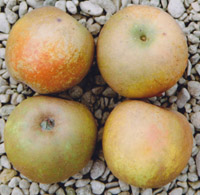 |
GOLDEN RUSSET (ALLGROVE) This Golden Russet was saved from Allgrove’s Nursery at Middle Green, Buckinghamshire when the last Mr Allgrove died. Allgrove’s was a long established nursery that went back to the 19th century when it was owned by Veitch’s. Nick Houston, who was close to the family, retrieved some of the varieties when the nursery closed and the trees were at risk. Nick Houston passed Golden Russet to Mr and Mrs Weaser of Shoreham, Kent; they passed it to the late Canon Donald Johnson and he passed it to us. It is slightly more uniformly russeted than the version above, but russet can vary from place to place and year to year, and we continue to observe similarities and differences. This version also conforms to the historical descriptions (above) and is a very rich apple to eat. Ripe in October and lasting to the year end. Pollination Group 3 |
|||
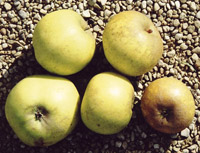 |
GOLDEN
RUSSET (CLARKE) Long considered ‘lost’, the Golden
Russet is a very old and esteemed apple. According to Forsyth in 1810,
“The Golden Russet is a fine middle-sized Apple, of a golden-russet
colour, from which it takes its name. This is a good Apple, and keeps
long.” Hogg in 1884 repeats the words of Worlidge in 1676 who said
it was 'without dispute, the most pleasant apple that grows' and adds,
that it is a medium sized fruit, covered with yellowish russet, which
is thickest around the base and on the side next the sun. It sometimes
has a glossy red patch next the sun. The flesh is pale yellow, crisp,
sweet and perfumed, but not particularly juicy. It fruits best if the
tree is in a warm spot. In season December to March. Bunyard, in the 1920s,
adds that there is much confusion between this, the English Russet, and
the Roxbury Russet. He says he has never managed to obtain a true variety
of Golden Russet. Trees planted in the National Fruit Trials in 1923 were
removed some time ago. We now have two versions of Golden Russet and both
have a good claim to authenticity. This one is from Mr and Mrs Peter Clarke
of Benson, Oxfordshire. It seems to match Hogg’s and Scott’s
descriptions. Peter Clarke’s grandfather built his house in 1928,
within a mature orchard. This particular old tree was known as Golden
Russet by his grandfather. The apples are sometimes flatter than Hogg’s
description, but otherwise in accordance. The flesh is cream-yellow and
a little coarse. It is crisp, not particularly juicy but very rich. The
eye is small, open and in a shallow basin close to the end of the apple,
with a slightly knobbed ring of russet around it. The skin is pale gold
with lots of darker dots and variable russet, golden at the stalk end.
There is a hint of five ribs on the body. Ripe in October, storing to
January. We are grateful to Mr and Mrs P. Clarke for providing us with
scionwood for this and Meadfoot Wonder (see later). Pollination Group
5 |
|||
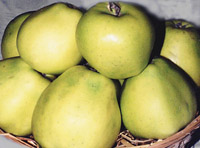 |
GOLDEN
SPIRE Discovered or rediscovered in Lancashire in the 1850s and
introduced by nurseryman Richard Smith of Worcester. In Gloucestershire
it was known as Tom Matthews and was used for cider making. A popular
19th century culinary apple, also eaten for dessert when fully ripe. Tangy
and quite richly flavoured, it can be watery if under-ripe. The fruits
are golden, long, and oblong. Crisp and juicy as a dessert apple, it cooks
to a well-flavoured, yellow purée. Golden Spire was used as an
ornamental tree in the formal garden or in the kitchen garden as it has
attractive pink blossom. Good crops and very hardy. Middle to late season.
Freely spurring. Pollination Group 2 |
|||
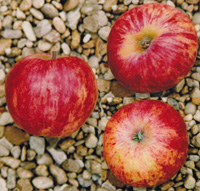 |
GOODY’S
GRAVENSTEIN There is nothing traditionally British about this
apple and it does not deserve to be included, under our normal rules of
inclusion. Nevertheless, we will break our own rules and here it is. It
is just too good to ignore. It came from an old garden/orchard, dating
from the early 1900s, owned by Mr Goody, an old pioneer homesteader, whose
business was logging, on Gambier Island, Howe Sound in British Columbia,
Canada. He seems to have been a bit of a character and kept a tame squirrel
in his pocket. It seems likely that it was a seedling of Gravenstein,
bred by him, but the origin remains obscure, beyond it being known locally
as Goody’s Gravenstein. It is much more colourful than, and different
in character from, Gravenstein, which is an old German apple predating
1669, when its arrival was noted in Denmark. Fuller details are included
below under Gravenstein. Many apples have been bred from Gravenstein,
but we doubt many are better than Goody’s Gravenstein. This apple
was discovered by Dick Hammond and later, with his wife Jo, they went
to the nearby Gambier Island to take some grafts to produce their own
tree. In 2008, their daughter Patricia, a professional singer, called
at our nursery to tell us all about it, with great enthusiasm. Dick had
recently died and this was his favourite apple. Jo subsequently sent some
scionwood and all the historical details. We reserved judgement, but when
our tree first fruited in 2012 we knew they were right and that this apple
is special. A uniform and pretty medium-sized apple, sometimes large.
The skin has a light bloom, but is waxy and shiny in the hand. It is pale
green but almost entirely covered with crimson feathery streaks, some
broader flashes and patches. The flesh is crunchy, crisp, very juicy,
sweet, without much sharpness, and with a delicate flavour hinting of
strawberries. Depending on the year’s weather and the place, it
is ripe in late August to mid September, and it keeps well for several
weeks. Like Gravenstein, it seems very hardy. The winters of British Columbia
can be harsh. With us it is unflinching in cold temperatures and willing
to fruit when young. An excellent and very pretty apple. We are most grateful
to all the Hammond family for their help and for allowing it to find its
way here. Pollination Group 3 |
|||
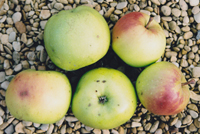 |
GOOSEBERRY
PIPPIN Closer observation leads us to believe that this is the
same as the ‘Gooseberry’ previously listed separately. The
latter is said to be a Kentish apple, first recorded in 1826, when in
the first collection catalogue of the London Horticultural Society. It
was likely named for its bright green appearance and the sharpness of
its flesh. It was widely grown for the market in the 19th century as a
sauce apple. We discovered Gooseberry Pippin in the Grove Heritage Collection
in Tasmania, and they sent us scions in 2005. We wondered whether it was
the same as Gooseberry, but early signs suggested it was different. It
was surely taken out to Australia by early settlers. It is a remarkably
sharp, late season cooking apple, which cooks quickly to a purée
the flavour of lemon juice. With sugar added it makes the richest apple
sauce we have known. The apples are hard and stay on the tree, even into
the New Year, and will last well, but can be used from early November.
T* Pollination Group 4 |
|||
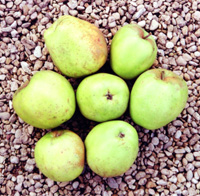 |
GORDON
PRESTON In 2016, Pat and Gordon Preston of Minster Lovell village,
west of Oxford, told us about some old apple trees they had and we visited
to receive an interesting tale surrounding the trees. One was the Original
Blenheim, recorded separately in this catalogue. The other was an apple
unmatched in its DNA and now named after the late Gordon Preston. The
Prestons had taken a keen interest in their home’s history which
had been in the family for generations. It began with the Chartist Movement
of 1838, which was a political movement aiming to attain universal male
suffrage (the Vote). They were strongest in 1839-48. They also believed
in making available a home and a piece of land to those without such means
of self sufficiency and built an estate of houses with large gardens on
the edge of Minster Lovell. There was the suspicion that their real motive
was to increase the number of votes in a marginal constituency! This was
in 1848 and it seems likely that apple trees were planted contemporaneously
in the gardens of the new houses. Several of these other properties have
old apple trees. Certainly this tree and the Original Blenheim, still
in good health with Pat Preston look to be of that age. Gordon was adamant
at our meeting that no building or trees were present before 1848. ‘Gordon
Preston’ is normally ripe in October, but perhaps earlier in hot
years, and we have kept them here in good condition to the year end. Medium
to large, they are sometimes rounded but most are conical and ribbed,
especially around the eye and some have a waist. Green turning pale yellow,
they are occasionally russeted with cream coloured flesh. They are juicy
enough and nicely sweet, with a rich lemony flavour and not particularly
acid. They are also valuable cooking apples, cooking quickly and not giving
up much juice, needing more added water. They keep their shape completely
and the flesh is excellent for tarts becoming very rich indeed, lemony
and tangy at the back of the throat. It is quite sweet enough, but a little
sugar might be preferred by some. Excellent dual purpose. Pollination
Group 5 |
|||
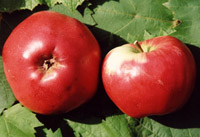 |
GRAND
DUKE CONSTANTINE An old Crimean apple, widely grown in Europe
including England. It was already established in Britain by 1850, and
was in existence in 1905, but has not been known here since. Reintroduced
to Britain by us in 2005, following our discovery of it in the Grove Research
Station, Tasmania. Grand Duc de Constantine is also a synonym of Alexander,
but this is a different apple, even though they are superficially similar.
It was named after a Russian admiral, Grand Duke Constantine. It is both
a culinary apple and a sharp/bittersharp cider apple. It is ready in the
middle of September but does not keep for long. It was reported to ripen
in Thirsk, North Yorkshire in November, so it will grow in the north.
The large apples have skin of clear yellow, almost covered in crimson
streaks near the sun. The flesh is white, tender, juicy and sweet, with
a balsamic aroma. Pollination Group 4 |
|||
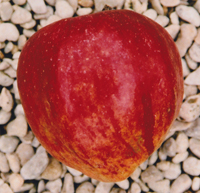 |
GRAND
SULTAN According to Scott in 1872 in ‘The Orchardist’
this apple was introduced from Russia in 1864. It has been found in numbers
in North Devon and Gloucestershire. Though confused in the past with White
and Yellow Transparent it is not the same. It resembles Duchess of Oldenburg
and is just as pretty an apple, and redder. It has been said to be a dual
purpose apple but is much better for eating raw than cooking. Ripe in
early September, the flesh is crisp, fine textured, sweet and juicy with
good acid and a very complex rich flavour. When cooked it keeps its shape,
is sweet and develops more acidity but there is still no need for sugar.
Some flavour is lost. An attractive and tasty apple. Pollination Group
5 |
|||
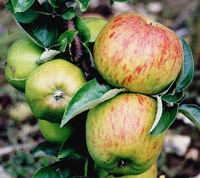 |
GRANGE’S
PEARMAIN The first reference to this apple was in the London
Horticultural Society catalogue of 1826. Hogg records that it was raised
by James Grange, market gardener from Kingsland, Middlesex, who also had
fruit shops in Covent Garden and Piccadilly. A large, dual purpose, usually
pearmain-shaped apple (i.e. longish oval) but sometimes more round and
flatter. It has yellow skin tinted green, and with pearly specks on the
shaded side and broken stripes and spots of crimson and russet where exposed
to the sun. The flesh is yellow-white, crisp, dense but tender, juicy
and sweet, having a rich lemony flavour with hints of melon and cucumber.
A dessert apple that is also good when baked. Scott considered it unsurpassed
for baking. It has a fragrant and very fruity scent and very rich flavour,
if kept for a while. Ripe at the end of October or early November, it
keeps to February. Bunyard describes this as the nearest approach to the
Newtown Pippin – a compliment. He said it stores until May, that
it was probably introduced by Dickson's of Chester before 1829 and that
it keeps well, retaining its crisp, juicy flesh in the spring. It has
also been used for cider. An excellent dessert apple. T* Pollination Group
4 |
|||
|
||||